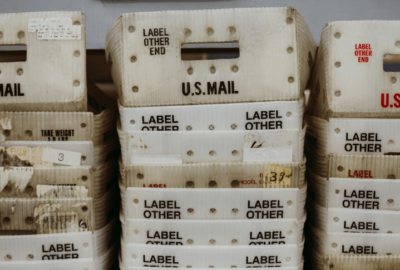Large increase in military members diagnosed with COVID-19
In today's Federal Newscast, 403 new troops were diagnosed with COVID-19 in one day.
To listen to the Federal Newscast on your phone or mobile device, subscribe in PodcastOne or Apple Podcasts. The best listening experience on desktop can be found using Chrome, Firefox or Safari.
- The military is seeing a large increase in service members infected with coronavirus. 403 new troops were diagnosed with COVID-19 in one day. A majority of those cases came from the Army. That brings the total of infected service members to just under 3,000. On top of that, 817 military civilians, 653 dependents and 336 contractors have gotten the disease. The grand total of Defense Department related cases is about 4,700. To date there have been 19 fatalities.
- 9 industry groups are calling on the Office of Federal Procurement Policy to issue governmentwide guidance to make sure contractors who can’t work because of the coronavirus pandemic can get paid. The stimulus bill authorized agencies to reimburse contractors if employees can’t telework or go into agency facilities. The industry groups say individual agency guidance while helpful are creating inconsistent or contradictory implementations. Instead OFPP should issue guidance to ensure that all agencies understand the acquisition tools available and have a consistent approach to keep vendors in a state of ready. (Federal News Network)
- Six industry associations are pushing for more IT modernization funding. The coronavirus pandemic has highlighted the real differences between agencies that have spent time and money on IT modernization and those that haven’t. For that reason, six industry groups are pressing lawmakers and the Trump administration to use future appropriations and stimulus bills to directly fund agency modernization efforts. The IT Industry Council, the Alliance for Digital Innovation, the Computing Technology Industry Association, the Center for Procurement Advocacy, the Internet Association and the Cybersecurity Coalition say future IT modernization funding should focus on telework enabling initiatives such as secure cloud adoption and digital services. (Information Technology Industry Council)
- Telework participation across government was up slightly in 2018. That’s according to newly released data from the Office of Personnel Management. 22% of federal employees teleworked at some point in 2018. That’s up one percent over the previous year. Telework eligibility dipped slightly to 42%. That’s one percent lower than the previous year. Some agencies have active telework programs. But one agency had just a single employee eligible for telework. The latest results shed light on the massive task agencies had in recent weeks to maximize telework during the pandemic. (Federal News Network)
- With millions of people expecting coronavirus payments, the Treasury Inspector General for Tax Administration launched a website to combat related scams. This comes a week after TIGTA warned taxpayers to stay alert for fraudsters impersonating IRS officials. The site reminds taxpayers that the IRS usually doesn’t call them about tax matters and doesn’t ask for personal or financial information by email, text, or social media. (Department of the Treasury)
- You might expect business formations to drop because of a halted economy, now the Census Bureau has new statistics to detail it. Responding to what it calls overwhelming numbers of requests from its regular data users, Census has developed a weekly business formations data series at the individual state level. Until now the series showed regional levels. Census will publish the new data each Thursday at noon, for a limited time and will assess ongoing demand. Last week new business formations were down 21% versus the same week last year.
- The slump in the economy has the Air Force worried. Air Force acquisition chief Will Roper says the government needs quick and bold investments in the space and aerospace industry to keep it afloat. Those two sectors are being hit hard by the coronavirus’ economic fallout. Roper says he does not want innovation to be a casualty in the war against the disease. The Air Force is in constant contact with Congress on what kind of stimulus the military needs to keep its defense industrial base intact. Meanwhile, the service is continuing to award contracts and engage directly with small business. (Federal News Network)
- The Navy has identified the sailor who became the first U.S. servicemember to die from COVID-19. Chief Petty Officer Charles Robert Thacker was one of several hundred crewmembers on the U.S.S. Theodore Roosevelt who’d tested positive for the virus. Chief Thacker’s spouse is also in the military. She flew from San Diego to Guam while he was in the ICU, and was at his bedside when he passed away.
- Like everyone else, military members have stopped going on vacation. So the Defense Department is letting them keep more vacation days in the bank to use later. The new policy raises the ceiling for how much annual leave service members can keep on the books from 60 days to 120 days. They’ll be able to keep accruing extra leave above that usual 60-day threshold until September. After that, any extra days they’ve racked up will be available to use for the next three years. DoD says it still wants commanders to encourage members to use their leave in the same year they earned it, but that the department needs to make allowances for exigent circumstances.
- Veterans Affairs says it’s implementing austerity measures to ensure employees working with COVID-19 patients have the protective gear they need. Employees not working with coronavirus patients will receive one mask a day. Employees working in VA community living centers, spinal cord injury units and inpatient mental health units will get one mask a day. VA will continue to distribute N-95 masks to employees working directly with COVID-19 patients. Veterans Health Administration leader Richard Stone says employee safety is his most important responsibility. (American Federation of Government Employees)
- Democrats on the House Veterans Affairs Committee say the Office of Management and Budget is holding up the release of relevant documents about VA’s coronavirus response. They say VA has been briefing the committee every week on its coronavirus response. But members are still looking for more information. VA says it’s cleared guidance, policy and other documents about its medical supply chain for the committee to review. But OMB must review those documents first. Lawmakers say OMB has created a bureaucratic log-jam with VA that hadn’t existed before the health crisis. (House Veterans Affairs Committee)
- The House Rules Committee will decide on a low-tech way for lawmakers to cast votes during the pandemic. Committee Chair Jim McGovern (D-Mass.) recommends a temporary rule change, authorizing some members to vote in-person on behalf of others. Members who can’t make it to the Capitol must instruct their proxies on how they intend to vote. McGovern said this low-tech plan would avoid technology susceptible to hacking or interference from malicious actors. House and Senate leaders expect members to reconvene May 4.
- A federal appeals court has given a postal regulator more to consider. D.C. District Court of Appeals tells the Postal Regulatory Commission to rethink the formula it uses to determine whether the Postal Service’s package business generates enough revenue to cover its costs. Judges say the PRC’s formula doesn’t factor in costs unique to its package and shipping business. USPS has a price cap on first-class mail, its most profitable product. But it has more pricing flexibility for its package products, as long as its monopoly mail business doesn’t subsidize package delivery. (Federal News Network)
- NASA’s governmentwide acquisition contract called SEWP is experiencing a surge in use over the last month. In March, agencies bought 40% more technology products and services off of the G-WACK than the previous month, while revenue for NASA SEWP grew by 25%. Agencies are specifically buying products from Citrix, McAfee and IBM. NASA expects SEWP to handle more than 50 thousand orders in fiscal 2020 to continue on its growth rate of 20% to 25% a year for the past five years. (Federal News Network)
Copyright © 2025 Federal News Network. All rights reserved. This website is not intended for users located within the European Economic Area.
Eric White
Eric White is news anchor and Federal Drive producer at Federal News Network.
Follow @FEDERALNEWSCAST
Related Stories
Getty Images/iStockphoto/Gradivis





